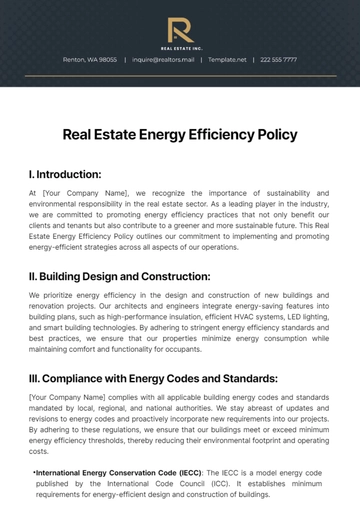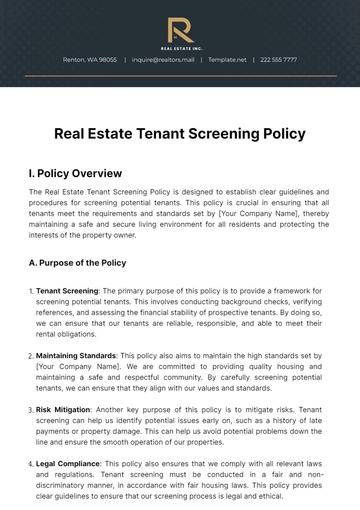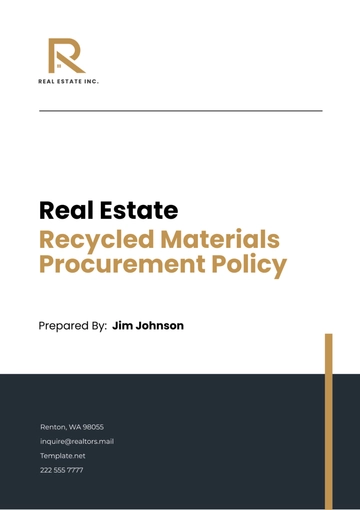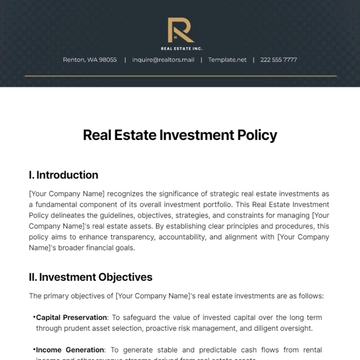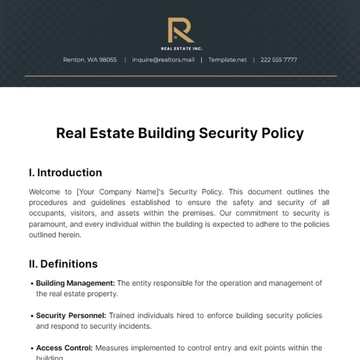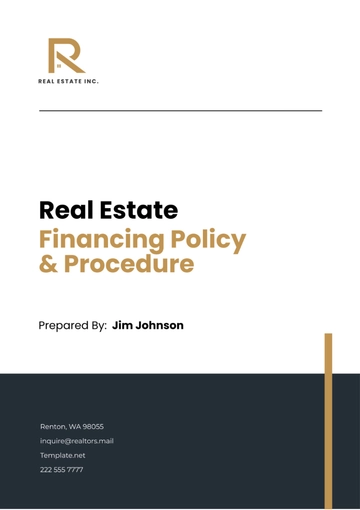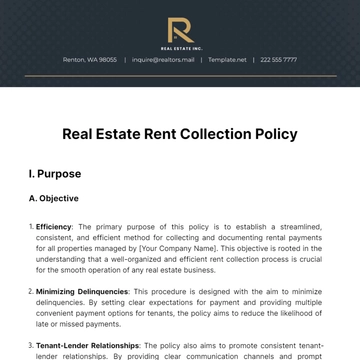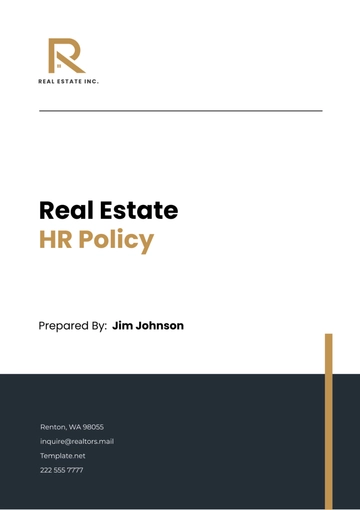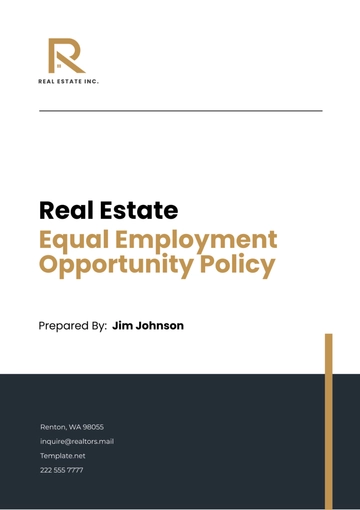Free Real Estate Financing Policy & Procedure
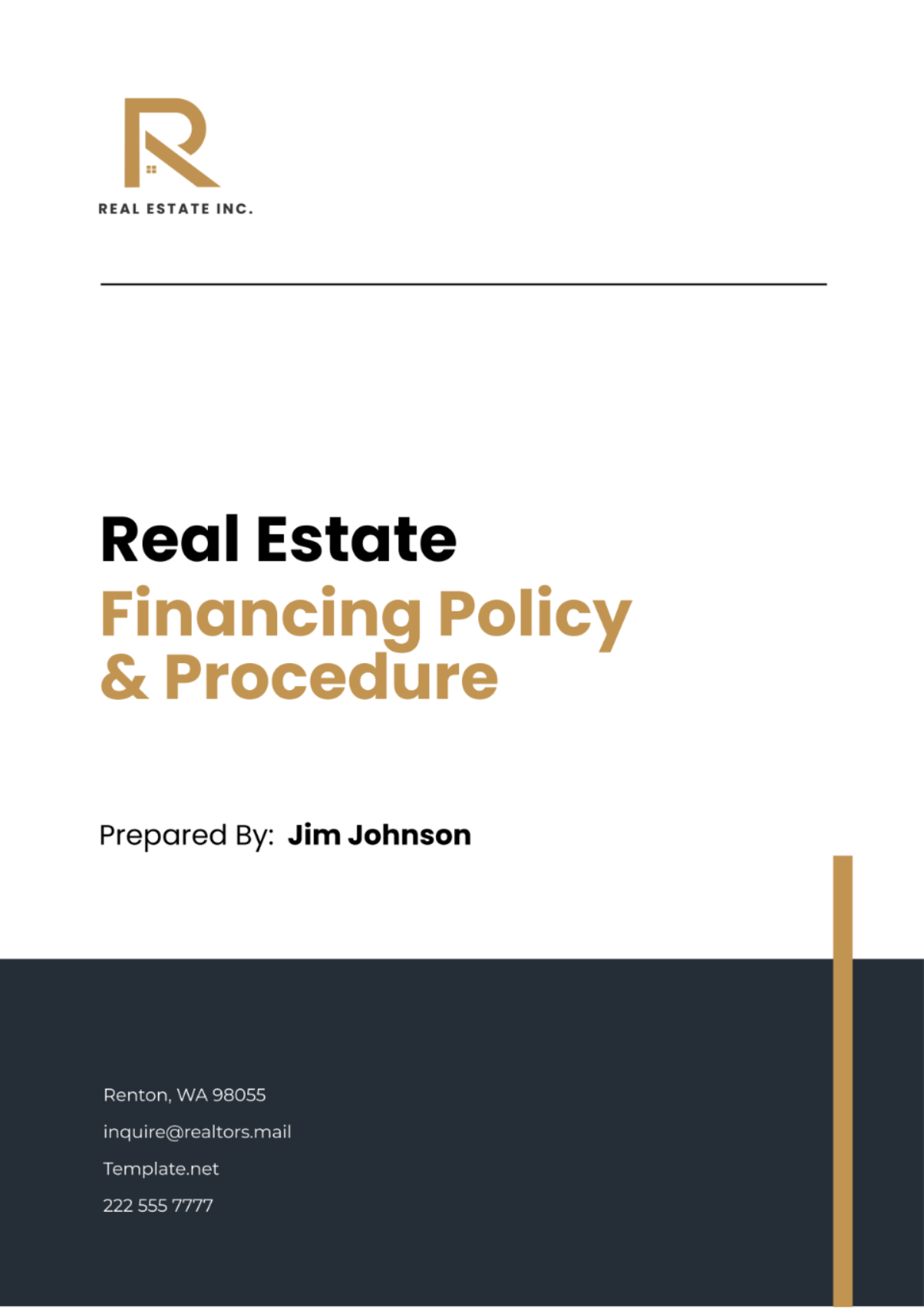
I. Introduction
A. Purpose
The purpose of this Real Estate Financing Policy & Procedure document is to establish a comprehensive framework that guides our approach to securing financing for real estate transactions. This framework is designed to ensure that all financing activities are conducted in a manner that is consistent, transparent, and aligned with our strategic objectives. By setting forth these guidelines, we aim to optimize our financing strategies, manage risks effectively, and uphold our commitment to fiscal responsibility and regulatory compliance.
B. Scope
This document applies to all real estate financing activities undertaken by our organization. It encompasses a wide range of financing options, including but not limited to mortgage financing, bridge loans, construction loans, and refinancing opportunities. The policy is intended for use by all employees involved in the financing process, from initial planning and application to the monitoring and reporting of loan performance. This includes our finance team, project managers, executives, and any other stakeholders directly involved in real estate transactions.
C. Definitions
In this document, we use several terms specific to real estate financing. Understanding these terms is crucial for interpreting the policy correctly. Below is a list of key definitions:
Mortgage Financing: Loans secured by real property through mortgage note.
Bridge Loan: Short-term financing used until permanent option is secured.
Construction Loan: Short-term, interim loan for financing the construction of a building or property.
Leverage: The use of borrowed capital for (real estate) investments.
Credit Risk: The risk of loss arising from a borrower's failure to repay a loan or meet contractual obligations.
II. Policy Overview
Our Real Estate Financing Policy is structured to support our strategic goals by providing a clear, robust framework for financing activities. We aim to leverage a variety of financing options to enhance our real estate portfolio's value while managing the associated risks effectively. To achieve this, we focus on a few core financing strategies:
Prioritizing financing options that offer competitive interest rates and favorable terms to minimize costs and maximize flexibility.
Utilizing a mix of debt and equity financing to optimize our capital structure and leverage opportunities.
Implementing stringent risk management practices to assess and mitigate financial and operational risks associated with real estate financing.
III. Roles and Responsibilities
Effective real estate financing requires the collaboration and expertise of various roles within our organization. Below is an outline of key roles and their associated responsibilities:
Finance Team: Responsible for identifying financing needs, exploring financing options, conducting risk assessments, and preparing loan applications. They also manage relationships with lenders and monitor loan performance.
Project Managers: Oversee the development of projects financed, ensuring they adhere to budgets and timelines. They work closely with the finance team to provide necessary project information for financing applications and reporting.
Executive Management: Provides oversight and strategic direction for financing decisions. Executive management is responsible for approving major financing decisions based on recommendations from the finance team.
Compliance Officer: Ensures all financing activities comply with internal policies and external regulatory requirements. This includes reviewing loan agreements and ensuring adherence to reporting standards.
IV. Financing Strategies and Criteria
A. Types of Real Estate Financing
Our organization leverages various types of real estate financing to support our portfolio's growth and diversification. Each financing type is selected based on its suitability to our project's needs and strategic goals. Below are the primary types of financing we employ:
Mortgage Financing: A long-term financing solution where the loan is secured by the property itself. Mortgage financing is ideal for purchasing existing buildings or land due to its relatively lower interest rates and the possibility of spreading repayments over many years.
Bridge Loan: This is a short-term loan used to "bridge" the gap until permanent financing is secured. Bridge loans are useful for acquisitions that need quick closing or for properties requiring improvements before securing long-term financing.
Construction Loan: Specifically designed for financing the construction of new buildings or extensive renovations. These loans typically have variable rates that convert to permanent financing upon project completion.
Refinancing: The process of replacing an existing loan with a new loan, usually to benefit from better terms or interest rates. Refinancing is considered when it offers significant savings or financial advantages over the existing loan arrangement.
B. Criteria for Choosing Financing
Choosing the right type of financing involves evaluating several key factors to ensure the selected option aligns with our project's needs and financial strategy. Below is a table outlining the criteria considered for each financing type:
Financing Type | Interest Rate | Term | Fees | Flexibility |
Mortgage Financing | Lowest among options | Longest, up to 30 years | Origination fees, closing costs | Moderate, depending on lender |
Bridge Loan | Higher due to short term | Short, usually up to 2 years | Due diligence, legal fees | High, good for quick transactions |
Construction Loan | Variable, can be high | Short to medium, until project completion | Construction administration fees | Medium, specific to project phases |
Refinancing | Varies, goal is to be lower than current | Varies, may extend or shorten original term | Closing costs, possibly prepayment penalties | Low, primarily used for better terms |
C. Considerations for Leverage and Debt Capacity
When determining our leverage and assessing our debt capacity, we consider the project's expected cash flows, the cost of debt, and our overall financial health. Proper leverage can enhance returns on equity, but excessive debt can increase risk and financial strain. Therefore, we meticulously analyze our debt service coverage ratio (DSCR), the property's loan-to-value (LTV) ratio, and our organization's overall debt-to-equity ratio to ensure that our financing decisions are sustainable and aligned with our risk tolerance and strategic objectives.
V. Risk Management
Managing the risks associated with real estate financing is critical to our organization's stability and success. We employ a structured approach to identify, assess, and mitigate these risks. Below is a table summarizing the primary financing risks, their likelihood, impact, and our mitigation strategies:
Financing Risk | Likelihood | Impact | Mitigation Strategy |
Interest Rate Risk | Medium | High | Fixing interest rates or using rate caps |
Credit Risk | Low | High | Thorough credit assessments, guarantees |
Market Risk | Medium | High | Diversification, flexible financing options |
Liquidity Risk | Low | Medium | Maintaining cash reserves, credit lines |
After identifying and assessing the risks, we prioritize those that could significantly impact our financial stability. For managing liability, we ensure adequate insurance coverage for all properties, maintain rigorous documentation and compliance practices, and establish reserves for unexpected financial obligations. This comprehensive risk management approach helps safeguard our assets and financial health, allowing us to navigate the complexities of real estate financing with confidence.
VI. Approval Process
A. Proposal Submission and Review
During the proposal submission and review stage, project managers or finance team members prepare a detailed financing proposal. This proposal includes the project's financial projections, the preferred financing option, and an analysis of risks and mitigation strategies. The proposal is then submitted to the designated review committee, which evaluates it based on strategic fit, financial viability, and risk profile. Feedback is provided, and revisions may be requested to ensure alignment with our organization's goals and risk tolerance.
B. Approval Authority
The approval authority within our organization is structured to ensure that financing decisions are made at the appropriate level, balancing efficiency with the need for oversight. Below is a table outlining the approval authority levels:
Authority Level | Project Size (USD) | Required Approvals |
Management Team | Up to 1 Million | Project Manager and Finance Manager |
Executive Committee | 1-10 Million | CFO and CEO |
Board of Directors | Over 10 Million | Full Board Approval |
C. Documentation and Due Diligence Requirements
Securing financing requires comprehensive documentation and due diligence to satisfy both our internal governance and external regulatory and lender requirements. The following is a list of key documentation and due diligence requirements:
Loan application form and business plan.
Financial statements and projections for the project.
Market analysis and feasibility studies.
Risk assessment report including mitigation strategies.
Property appraisals and environmental assessments.
Legal checks on property titles and zoning compliances.
VII. Loan Application and Execution
A. Preparing and Submitting Loan Application
The process of preparing and submitting a loan application involves gathering all necessary documentation, completing the lender's application forms, and crafting a compelling narrative about the project's potential and financial soundness. The finance team, in collaboration with project managers, ensures that the application clearly articulates the use of funds, expected returns, and risk management strategies, aligning with the lender's criteria to increase the chances of approval.
B. Negotiation of Terms and Conditions
Once the loan application is submitted and preliminary approval is received, negotiations on terms and conditions begin. This stage is crucial for securing favorable terms that align with our financial goals and project needs. Our guidelines for negotiation include:
Seek competitive interest rates that reflect the project's risk profile.
Negotiate flexible repayment terms to accommodate cash flow variations.
Ensure covenants and conditions offer sufficient operational flexibility.
Aim for minimal fees and costs associated with the loan.
C. Closing Process and Documentation
The closing process marks the final step in securing financing, involving the execution of loan agreements, disbursement of funds, and initiation of the repayment schedule. During this stage, our finance team collaborates with legal advisors to review all closing documents, ensuring they accurately reflect the agreed terms. We also prepare for the disbursement of funds by coordinating with project teams and lenders, ensuring a smooth transition to project execution. Proper documentation is maintained throughout this process for internal records and compliance purposes.
VIII. Monitoring and Reporting
A. Ongoing Monitoring
Ongoing monitoring is a crucial component of our real estate financing process, ensuring that all financed projects remain aligned with our financial and strategic objectives. This involves regular assessments of project progress, financial performance, and risk exposure. Our finance team closely tracks the repayment schedules, interest rates adjustments, and compliance with loan covenants. Any deviations from planned benchmarks or the emergence of new risks trigger a review process to identify corrective actions, such as refinancing options, project adjustments, or renegotiation of loan terms.
B. Financial Reporting Requirements
Maintaining transparency and accountability through comprehensive financial reporting is a cornerstone of our financing policy. Below are the key reporting requirements:
Requirement | Frequency | Details |
Cash Flow Statements | Quarterly | Show cash inflows and outflows related to financing activities. |
Debt Service Coverage Ratio | Semi-annually | Demonstrate our ability to meet current debt obligations with operating income. |
Loan Balance and Interest | Quarterly | Provide updates on remaining loan balances and interest obligations. |
Project Progress Reports | Monthly | Detail the progress of projects in relation to the financing used. |
C. Regular Review and Reporting
Regular review and reporting are integral for the management team and stakeholders to stay informed about the performance and risks of our financing activities. This entails quarterly finance meetings to discuss reports, analyze trends, and make informed decisions. Additionally, an annual review is conducted to compare the actual performance against the financial projections and strategic objectives. This process ensures that our financing strategies remain effective and responsive to changing market conditions and organizational goals.
IX. Policy Review and Amendment
This Real Estate Financing Policy & Procedure document is subject to periodic review and amendment to ensure its continued relevance and effectiveness. The review process occurs annually or as necessitated by significant changes in market conditions, regulatory requirements, or our strategic direction. Amendments are proposed by the finance team, reviewed by senior management, and approved by the Board of Directors. This structured approach ensures that our financing policies and procedures remain aligned with best practices, regulatory requirements, and our organization's evolving needs.
- 100% Customizable, free editor
- Access 1 Million+ Templates, photo’s & graphics
- Download or share as a template
- Click and replace photos, graphics, text, backgrounds
- Resize, crop, AI write & more
- Access advanced editor
Maximize efficiency with the Real Estate Financing Policy & Procedure Template from Template.net. This resource is not just editable but also fully customizable, catering to your specific needs. Designed for clarity and compliance, it's readily adjustable in our AI Editor tool, ensuring you can craft and fine-tune your financing strategies with precision and ease.
You may also like
- HR Policy
- Restaurant Policy
- Company Policy
- Accounting Policies and Procedures
- Website Policy
- Privacy Policy
- Safety Policy
- School Policy
- IT and Software Policy
- Law Firm Policy
- Construction Policy
- Interior Design Policy
- Travel Agency Policy
- Education Academic Policy
- Security Policy
- Real Estate Policy
- Expense Policy
- Software Policy

